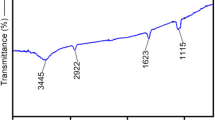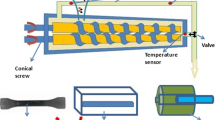Abstract
To fabricate the thermoplastic polyurethane (TPU) composites with excellent mechanical, thermal and shape memory properties, shape memory composites containing (TPU)/ethylene–vinyl acetate copolymer (EVA)/EVA grafting maleic anhydride (EVA-g-MAH)/functional graphene oxide nanosheets (fGONs) were designed, prepared and reported. The effects of VA contents (VA15 and VA40) in EVA on the compatibility of TPU/EVA blends were first evaluated and based on this, TPU/EVA/EVA-g-MAH/fGONs composites were investigated. The contact angle analysis revealed better interface compatibility of TPU/EVA40 compared to others, and fGONs tended to be distributed more in the TPU phase TPU phase. The enhanced compatibility of EVA and TPU can be attributed to the chemical interactions between EVA-g-MAH and TPU, as confirmed by FTIR and FESEM analysis. Increasing the proportion of EVA content in the TPU/EVA blend resulted in increasing elastic modulus. The mechanical characteristics of TPU composites containing GO and fGONs were enhanced compared with TPU/EVA and TPU/EVA/EVA-g-MAH. The shape memory performance examination indicated that EVA improved the shape fixation rate (Rf) of TPU, and the Rf was 147.3% higher than that of TPU. By incorporating 5% EVA-g-MAH, the blend demonstrated an increased Rf value of 79.60%, alongside a reduced shape recovery rate (Rr) of 75.5%. After adding fGONs, both the Rf and Rr were increased. The Rf and Rr of TPU/EVA/EVA-g-MAH/GO-IPDI composite reached 92.29% and 82.23%. DSC and DMA analysis revealed the glass transition temperature, storage modulus, and loss modulus of the composites were increased after adding fGONs.











Similar content being viewed by others
Data availability
Supportive data for the findings of this study is accessible from the corresponding author upon reasonable requests.
References
Wang K, Jia YG, Zhao C et al (2019) Multiple and two-way reversible shape memory polymers: Design strategies and applications. Prog Mater Sci. https://doi.org/10.1016/j.pmatsci.2019.100572
Kim YS, Harris R, Davis R (2012) Innovative approach to rapid growth of highly clay-filled coatings on porous polyurethane foam. ACS Macro Lett 1(7):820–824. https://doi.org/10.1021/mz300102h
Teng JH, Zhang MJ, Leung KT et al (2019) A unified thermodynamic mechanism underlying fouling behaviors of soluble microbial products (SMPs) in a membrane bioreactor. Water Res 149(1):477–487. https://doi.org/10.1016/j.watres.2018.11.043
Wang YK, Wang LC, Zhang YT et al (2020) Evaluating the effect of carbon black-a short carbon fiber hybrid filler on the electro-activated shape memory cyanate ester/epoxy composites. Sci Adv Mater 12(5):652–658. https://doi.org/10.1166/sam.2020.3687
Ohira S, Ueda Y, Nishiyama K et al (2016) Couch-height based patient setup for abdominal radiation therapy. Med Dosim 41(1):59–63. https://doi.org/10.1016/j.meddos.2015.08.003
Jing X, Mi HY, Huang HX et al (2016) Shape memory thermoplastic polyurethane (TPU)/poly(ε-caprolactone) (PCL) blends as self-knotting sutures. J Mech Behav Biomed Mater 64:94–103. https://doi.org/10.1016/j.jmbbm.2016.07.023
Xu X, Fan P, Ren J et al (2018) Self-healing thermoplastic polyurethane (TPU)/polycaprolactone (PCL)/multi-wall carbon nanotubes (MWCNTs) blend as shape-memory composites. Compos Sci Technol 168:255–262. https://doi.org/10.1016/j.compscitech.2018.10.003
Jafari Horastani S, Karevan M, Ghane M (2022) Structural, thermal, and viscoelastic shape-memory nanocomposites of low transition temperature. Polym Adv Technol 33(9):2720–2735. https://doi.org/10.1002/pat.5727
Wang Y, Wang Y, Liu M et al (2023) 4D printing light-/thermo-responsive shape memory composites based on thermoplastic polyurethane/polylactic acid/polyaniline blends. High Perform Polym 35(4):366–378. https://doi.org/10.1177/09540083221135499
Kim JH, Kim GH (2014) Effect of rubber content on abrasion resistance and tensile properties of thermoplastic polyurethane (TPU)/rubber blends. Macromol Res 22(5):523–527. https://doi.org/10.1007/s13233-014-2077-y
Anwer A, Bagheri Z S, Fernie G et al (2017) Evolution of the coefficient of friction with surface wear for advanced surface textured composites. Adv Mater Interfaces 4(6). https://doi.org/10.1002/admi.201600983
Sambruno A, Bañon F, Salguero J et al (2019) Kerf Taper defect minimization based on abrasive waterjet machining of low thickness thermoplastic carbon fiber composites C/TPU. Materials 12(24). https://doi.org/10.3390/ma12244192
Asim M, Jawaid M, Abdan K et al (2016) Effect of alkali and silane treatments on mechanical and fibre-matrix bond strength of kenaf and pineapple leaf fibres. J Bionic Eng 13(3):426–435. https://doi.org/10.1016/S1672-6529(16)60315-3
Cai S, Sun YC, Ren J et al (2017) Toward the low actuation temperature of flexible shape memory polymer composites with room temperature deformability via induced plasticizing effect. J Mater Chem B 5(44):8845–8853. https://doi.org/10.1039/c7tb02068f
Xu D, Zhou Y, Guo J et al (2022) Different component ratio of polyamide 1212/thermoplastic polyurethane blends: Effect on phase morphology, mechanical properties, wear resistance, and crystallization behavior. J Thermoplast Compos Mater 35(2):249–260. https://doi.org/10.1177/0892705719886009
Kumar S, Gupta TK, Varadarajan KM (2019) Strong, stretchable and ultrasensitive MWCNT/TPU nanocomposites for piezoresistive strain sensing. Compos Part B: Eng. https://doi.org/10.1016/j.compositesb.2019.107285
Rashmi B J, Loux C, Prashantha K (2017) Bio‐based thermoplastic polyurethane and polyamide 11 bioalloys with excellent shape memory behavior. J Appl Polym Sci 134(200). https://doi.org/10.1002/app.44794
Abidaryan S, Akhoundi B, Hajami F (2023) Additive manufacturing and investigation of shape memory properties of polylactic acid/thermoplastic polyurethane blend. J Elastomers Plast 55(2):201–222. https://doi.org/10.1177/00952443221147028
Ebrahimi AH, Sahebian S (2022) Influence of functional carbon nanotube and multi-cyclic shape memory performance on thermally triggered polyurethane nanocomposites. Polym Compos 43(12):8925–8934. https://doi.org/10.1002/pc.27073
Ehteramian M, Ghasemi I, Azizi H et al (2021) Functionalization of multi-walled carbon nanotube and its effect on shape memory behavior of nanocomposite based on thermoplastic polyurethane/polyvinyl chloride/multi-walled carbon nanotube (TPU/PVC/MWCNT). Iran Polym J 30(4):411–422. https://doi.org/10.1007/s13726-021-00900-5
Muhammad Imran S, Go GM, Hussain M et al (2022) Multiwalled carbon nanotube-coated poly-methyl methacrylate dispersed thermoplastic polyurethane composites for pressure-sensitive applications. Macromol 2(2):211–224. https://doi.org/10.3390/macromol2020014
Rohm K, Solouki Bonab V, Manas-Zloczower I (2021) In situ TPU/graphene nanocomposites: Correlation between filler aspect ratio and phase morphology. Polym Eng Sci 61(4):1018–1027. https://doi.org/10.1002/pen.25619
Shuai C, Wang Z, Peng S et al (2022) Water-responsive shape memory thermoplastic polyurethane scaffolds triggered at body temperature for bone defect repair. Mater Chem Front 6(11):1456–1469. https://doi.org/10.1039/d1qm01635k
Großmann L, Kieckhöfer M, Weitschies W et al (2022) 4D prints of flexible dosage forms using thermoplastic polyurethane with hybrid shape memory effect. Eur J Pharm Biopharm 181:227–238. https://doi.org/10.1016/j.ejpb.2022.11.009
Jing X, Mi HY, Peng XF et al (2015) The morphology, properties, and shape memory behavior of polylactic acid/thermoplastic polyurethane blends. Polym Eng Sci 55(1):70–80. https://doi.org/10.1002/pen.23873
Zhang M, Ji X, Lyu Y et al (2020) Shape memory effects of polynorbornene modified by in-situ reactive thermoplastic polyurethane. Polym Test. https://doi.org/10.1016/j.polymertesting.2019.106201
Lai SM, Lan YC (2013) Shape memory properties of melt-blended polylactic acid (PLA)/thermoplastic polyurethane (TPU) bio-based blends. J Polym Res 20(5). https://doi.org/10.1007/s10965-013-0140-6
Ren D, Chen YJ, Li H et al (2019) High-efficiency dual-responsive shape memory assisted self-healing of carbon nanotubes enhanced polycaprolactone/thermoplastic polyurethane composites. Colloids Surf A: Physicochem Eng Aspects. https://doi.org/10.1016/j.colsurfa.2019.123731
Zhou X, Hu B, Xiao W Q et al (2017) Morphology and properties of shape memory thermoplastic polyurethane composites incorporating graphene-montmorillonite hybrids. J Appl Polym Sci 135(15). https://doi.org/10.1002/app.46149
Wu G Z, Gu Y J, Hou X L et al (2019) Hybrid Nanocomposites of cellulose/carbon-nanotubes/polyurethane with rapidly water sensitive shape memory effect and strain sensing performance polymers. Polymers 11(10). https://doi.org/10.3390/polym11101586
Liu T, Huang R, Qi X et al (2017) Facile preparation of rapidly electro-active shape memory thermoplastic polyurethane/polylactide blends via phase morphology control and incorporation of conductive fillers. Polymer 114:28–35. https://doi.org/10.1016/j.polymer.2017.02.077
Guo Y, Yan L, Zeng Z et al (2020) TPU/PLA nanocomposites with improved mechanical and shape memory properties fabricated via phase morphology control and incorporation of multi-walled carbon nanotubes nanofillers. Polym Eng Sci 60(6):1118–1128. https://doi.org/10.1002/pen.25365
Cui YY, Dong BJ, Li BL et al (2013) Properties of polypropylene/poly(ethylene terephthalate) thermostimulative shape memory blends reactively compatibilized by maleic anhydride grafted polyethylene-octene elastomer. Int J Polym Mater Polym Biomater 62(13):671–677. https://doi.org/10.1080/00914037.2013.769225
Li SC, Tao L (2010) Melt rheological and thermoresponsive shape memory properties of HDPE/PA6/POE-g-MAH blends. Polym Plast Technol Eng 49(2):218–222. https://doi.org/10.1080/03602550903147320
Bianchi O, Zattera AJ, Canto LB (2010) Dynamic vulcanization of HDPE/EVA blend using silane. J Elastomers Plast 42(6):561–575. https://doi.org/10.1177/0095244310376918
Liu Y, Zhang J, Chen R et al (2017) Ethylene vinyl acetate copolymer modified epoxy asphalt binders: Phase separation evolution and mechanical properties. Constr Build Mater 137(15):55–65. https://doi.org/10.1016/j.conbuildmat.2017.01.081
Volpe V, Davino D, Sorrentino L et al (2018) Smart behavior of elastomeric composites produced by injection molding. J Appl Polym Sci 135(44). https://doi.org/10.1002/app.46863
Chen X, Huang L, Dong C et al (2019) Influence of vinyl acetate content on the surface hydrophobic recovery of ethylene vinyl acetate copolymer after plasma modification. Chem Select 4(5):1763–1765. https://doi.org/10.1002/slct.201803826
Alothman OY (2012) Processing and characterization of high density polyethylene/ethylene vinyl acetate blends with different VA contents. Adv Mater Sci Eng. https://doi.org/10.1155/2012/635693
Adriana BE, Eduardo R, Saúl S et al (2013) Morphology and mechanical properties of heterophasic PP–EP/EVA/organoclay nanocomposites. J Appl Polym Sci 128(5):3473–3479. https://doi.org/10.1002/app.38553
An J, Ju R, Zeng J et al (2022) Different inhibition mechanisms and safety effects of TPU and EVA on thermal decomposition of RDX. J Therm Anal Calorim 147(20):11261–11272. https://doi.org/10.1007/s10973-022-11370-z
Gama N, Godinho B, Barros-Timmons A et al (2022) Insights into PU/EVA blends produced using industrial residues towards eco-efficient materials. J Polym Environ 30(4):1451–1461. https://doi.org/10.1007/s10924-021-02289-x
Hummersjr WS, Offeman RE (1958) Preparation of graphitic oxide. J Am Chem Soc 80(6):1339. https://doi.org/10.1021/ja01539a017
Lin Y, Jin J, Song M (2011) Preparation and characterisation of covalent polymer functionalized graphene oxide. J Mater Chem 21(10):3455–3461. https://doi.org/10.1039/c0jm01859g
Bai JJ, Hu GS, Zhang JT et al (2019) Preparation and rheology of isocyanate functionalized graphene oxide/thermoplastic polyurethane elastomer nanocomposites. J Macromol Sci Part B 58(03):425–441. https://doi.org/10.1080/00222348.2019.1565102
Zhou X, Xiao WQ, Jiang H et al (2017) Preparation and properties of blended PVDF/TPU composite. Plast Ind 45(04):40–43. https://doi.org/10.3969/j.issn.1005-5770.2017.04.011. (in Chinese)
Yan F, Zhang M, Zhang L et al (2017) Interaction and compatibilization mechanism of polyvinylidene fluoride/polyether thermoplastic polyurethane elastomer blends. Chemical J Chin Univ 38(5):888–895. https://doi.org/10.7503/cjcu20160822. (in Chinese)
Lai SM, You PY (2018) Preparation and characterization of ethylene vinyl-acetate copolymer/silicone blends with excellent two-way shape memory properties. Macromol Res 26(11):984–997. https://doi.org/10.1007/s13233-018-6134-9
Acknowledgements
This work was financial supported by the Cooperation project of Chunhui plan of the ministry of education of China (Z2023XXX, Z2017070); Interface innovation research studio project for College Students of Xihua University (2019-07); Construction project of “Double Carbon” material innovation research studio of Xihua University; College students innovation and entrepreneurship project of Sichuan Province (S202110650004, S202110650005) and “Xihua Cup” innovation and entrepreneurship training program of Xihua University (xhb2023067, xhb2023068).
Funding
Interface innovation research studio project for College Students of Xihua University, 2019-07, Jun Bian, Construction project of “Double Carbon” material innovation research studio of Xihua University, S202110650004, Jun Bian, S202110650005, Jun Bian, College students innovation and entrepreneurship project of Sichuan Province, S202110650004, Jun Bian, S202110650005, Jun Bian, Xihua Cup” innovation and entrepreneurship training program of Xihua University, xhb2023067, Jun Bian,xhb2023068, Jun Bian, the Cooperation project of Chunhui plan of the ministry of education of China, Z2023XXX, Jun Bian, Z2017070, Jun Bian.
Author information
Authors and Affiliations
Contributions
Wei Zhao: Conceptualization, experimentation, analysis, manuscript writing. Yi Guo, Tong Tong Jin, Xin Kang Li, Shang Ke Yang, Ai Ping Zhang: Conceptualization, validation, review. Hai Lan Lin, Jun Bian, Dai Qiang Chen: Conceptualization, validation, writing- review & editing, supervision, secured financial funding.
Corresponding authors
Additional information
Publisher's Note
Springer Nature remains neutral with regard to jurisdictional claims in published maps and institutional affiliations.
Highlights
• A facile strategy through incorporating EVA-g-MAH compatibilizer and functional graphene oxide nanosheets (fGONs) to improve the compatibility of TPU/EVA blends to prepare TPU shape memory composites has been proposed.
• A comprehensive investigation was conducted on TPU shape memory composites, focusing on enhancing their mechanical, thermal, and phase morphology was controlled to enhance the mechanical, thermal, and shape memory properties.
• The chemical interactions between EVA-g-MAH and TPU, fGONs and TPU contributed to the increasing compatibility and property improvements of TPU shape memory composites.
• This study introduces an innovative approach to fabricate TPU shape memory composites and is anticipated to inspire future research and development in the field of intelligent materials and shape memory composites.
Rights and permissions
Springer Nature or its licensor (e.g. a society or other partner) holds exclusive rights to this article under a publishing agreement with the author(s) or other rightsholder(s); author self-archiving of the accepted manuscript version of this article is solely governed by the terms of such publishing agreement and applicable law.
About this article
Cite this article
Zhao, W., Lin, H.L., Guo, Y. et al. TPU/EVA shape memory composites with improved properties fabricated via synergic incorporation of EVA-g-MAH compatibilizer and functional graphene oxide nanosheets. J Polym Res 31, 74 (2024). https://doi.org/10.1007/s10965-024-03929-1
Received:
Accepted:
Published:
DOI: https://doi.org/10.1007/s10965-024-03929-1




